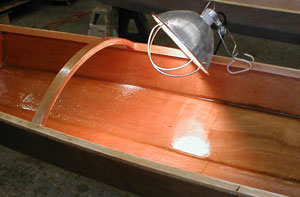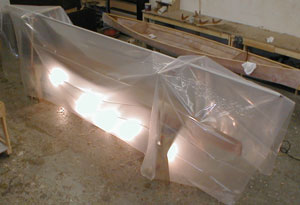Builders' Forum |
|
| ↓ Scroll to Last Comment ↓ | Forum Guidelines | Builders' Forum | |
building my first boat. Applied epoxy in cold conditions, but kept a heater on in garage for a few days. It has now been six days and epoxy is still not cured enough to sand. The mix was correct. I am concerned the temperature was too low for proper curing. When sanding it does not powder off, but rolls into small balls. Will this eventually cure or am I in trouble?
2 replies:
RE: Epoxy is not cured - gummy
How cold, exactly?
Epoxy is an exothermic reaction; it needs to generate heat to activate. No matter which brand of epoxy, the chemistry pretty much grinds to a halt once you dip below 60 degrees F. One epoxy chemist told me that the cure time doubles for every ten degrees below 78F. (That was some years ago. I think most of the low-viscosity brands have goosed the blend for faster activation, including MAS. But I still consider 60 degrees to be the absolute floor.)
REAL freezing temps, in the 30's or below, really seem to damage the epoxy. I've seen epoxy that was frozen subsequently refuse to cure at any temperature.
Epoxy applied in the marginal zone, 45-60 degrees F, is going to take ages to activate (and may NEVER reach a full-strength cure if action isn't taken).
Fortunately the fix is simple: Cook your boat. Pull a plastic sheet over the assembly, aim a space heater under this tent, and get it up to 80 or 90 degrees in there. Or even more. And keep it there for 24 hours at least, longer if you can. Then let it cool back down. If the epoxy was in fact mixed properly, it'll be good to go at that point.
You need to think about temperatures in your workspace as a bigger issue than a satisfactory reading on the wall thermometer. A common failure mode I've observed is that the builder heads out into the shop and the thermometer on the wall reads 40, so the heat is cranked. The thermometer drifts upwards: 56, 57, 58. Impatiently, epoxy is mixed and applied. But the BOAT ITSELF is still only 48 degrees! The epoxy chills the moment it hits the surface, slowing the chemical chain reaction nearly to a halt and, at best, resulting in weak bonds.
If you have to live with a cold shop, it's more important to keep your jugs of epoxy and the boat itself warm than it is to keep the ambient air temperature up. Keep the epoxy inside, or keep a light bulb trained on the epoxy jugs so that they stay at a balmy 75-80 degrees. And use a cheap plastic drop cloth as a tent to keep the boat itself warm.
More on epoxy and cold weather here.
If cooking your boat doesn't solve the problem, we'll have to revisit the possibility of a bad mix. Hey, I've made more bad batches than I can count, and I ought know better!















RE: Epoxy is not cured - gummy
» Submitted by hspira - Fri, 4/15/16 » 9:51 PM
this does not sound good. but before we go there, what has been the temperature for the six days?
and when you said 'applied epoxy'....were you glassing something....just coating something with epoxy... can you be a bit more specific about what you were epoxying/sanding and how much area is affected?
also, if you kept the mixing cup for the epoxy and you bring it inside a warm house for a day (70 degrees or more) ...does the epoxy in the mixing cup harden?
that will help us help you.
h